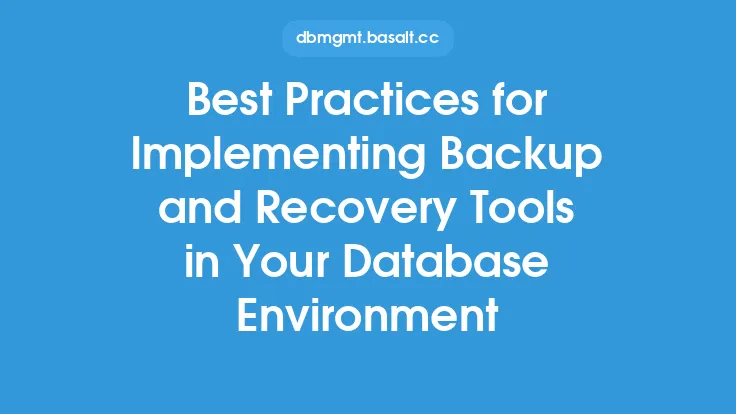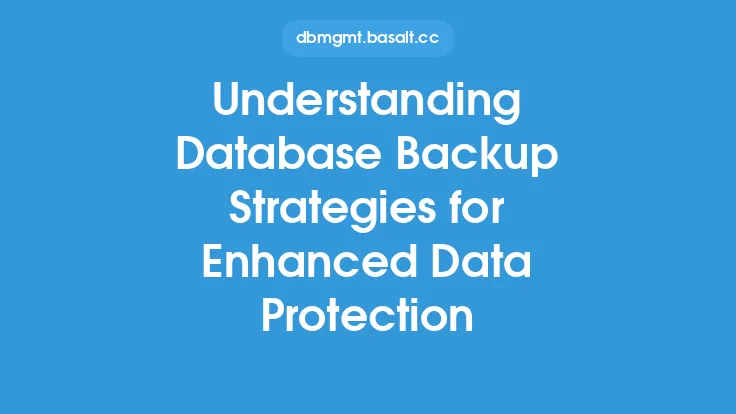Developing a comprehensive database backup strategy is crucial for any organization that relies on databases to store and manage critical data. A well-planned backup strategy ensures that data is protected against loss, corruption, or unauthorized access, and can be quickly recovered in the event of a disaster or system failure. In this article, we will discuss the key components of a comprehensive database backup strategy and provide guidance on how to develop a strategy that meets the unique needs of your organization.
Understanding Database Backup Requirements
Before developing a database backup strategy, it is essential to understand the backup requirements of your organization. This includes identifying the types of data that need to be backed up, the frequency of backups, and the retention period for backup data. You should also consider the recovery time objective (RTO) and recovery point objective (RPO) for your databases, which will help determine the frequency and type of backups required. Additionally, you should assess the current backup infrastructure, including the backup software, hardware, and network resources, to ensure that they are adequate to support the backup strategy.
Identifying Database Backup Types
There are several types of database backups, including full backups, incremental backups, and differential backups. Full backups involve backing up the entire database, while incremental backups involve backing up only the changes made since the last backup. Differential backups involve backing up all the changes made since the last full backup. You should determine which type of backup is most suitable for your organization, based on factors such as the size of the database, the frequency of changes, and the available backup window.
Developing a Backup Schedule
A backup schedule is a critical component of a comprehensive database backup strategy. The schedule should outline the frequency and timing of backups, as well as the type of backup to be performed. You should consider factors such as the backup window, the availability of system resources, and the impact of backups on system performance. The schedule should also include provisions for regular full backups, as well as incremental or differential backups, to ensure that data is protected against loss or corruption.
Choosing a Backup Destination
The backup destination is the location where backup data is stored. You should choose a backup destination that is secure, reliable, and easily accessible. Options for backup destinations include local disk, tape, cloud storage, and offsite storage. You should consider factors such as the cost of storage, the availability of storage space, and the ease of data recovery when selecting a backup destination.
Ensuring Backup Integrity
Ensuring the integrity of backup data is critical to a comprehensive database backup strategy. You should implement measures to verify the integrity of backup data, such as checksums or digital signatures, to ensure that data is not corrupted or tampered with during the backup process. Additionally, you should regularly test backup data to ensure that it can be successfully recovered in the event of a disaster or system failure.
Automating Backup Processes
Automating backup processes is essential to a comprehensive database backup strategy. Automation ensures that backups are performed consistently and reliably, without the need for manual intervention. You should use backup software that supports automation, such as scheduling and scripting, to ensure that backups are performed according to the backup schedule. Additionally, you should implement alerts and notifications to ensure that backup failures or errors are quickly detected and addressed.
Monitoring and Maintaining Backup Systems
Monitoring and maintaining backup systems is critical to a comprehensive database backup strategy. You should regularly monitor backup systems to ensure that they are functioning correctly, and perform maintenance tasks such as software updates and hardware checks to ensure that systems are running smoothly. Additionally, you should regularly review backup logs and reports to ensure that backups are being performed successfully, and make adjustments to the backup strategy as needed.
Testing and Validating Backup Data
Testing and validating backup data is essential to a comprehensive database backup strategy. You should regularly test backup data to ensure that it can be successfully recovered in the event of a disaster or system failure. This includes testing the recovery process, as well as verifying the integrity and consistency of recovered data. Additionally, you should validate backup data to ensure that it is complete and accurate, and make adjustments to the backup strategy as needed.
Documenting the Backup Strategy
Documenting the backup strategy is critical to a comprehensive database backup strategy. You should maintain detailed documentation of the backup strategy, including the backup schedule, backup types, and backup destinations. This documentation should be easily accessible and understandable, and should be regularly reviewed and updated to ensure that it remains accurate and relevant. Additionally, you should ensure that all stakeholders, including IT staff and management, are aware of the backup strategy and their roles and responsibilities in implementing and maintaining it.
Reviewing and Updating the Backup Strategy
Finally, reviewing and updating the backup strategy is essential to a comprehensive database backup strategy. You should regularly review the backup strategy to ensure that it remains effective and relevant, and make adjustments as needed to reflect changes in the organization, technology, or business requirements. This includes reviewing the backup schedule, backup types, and backup destinations, as well as assessing the effectiveness of the backup strategy in protecting against data loss or corruption. By regularly reviewing and updating the backup strategy, you can ensure that your organization's data is protected and available, and that the backup strategy remains aligned with business objectives and requirements.





